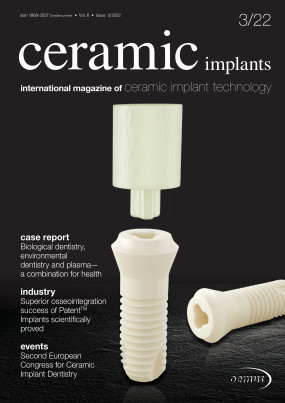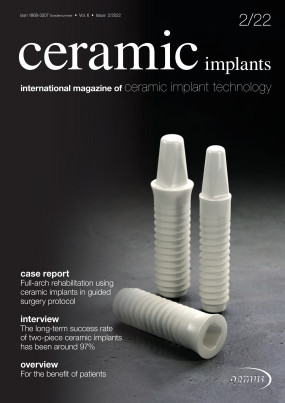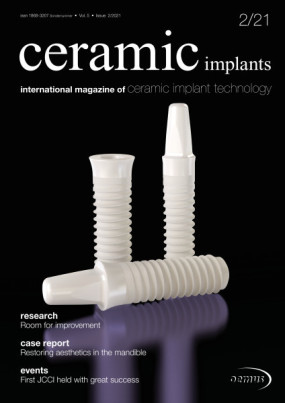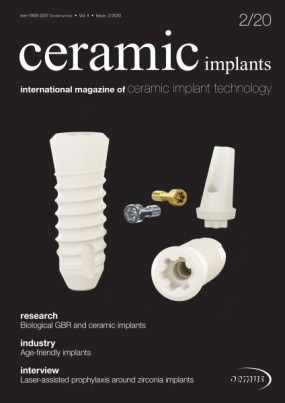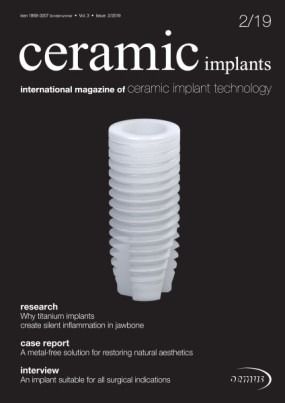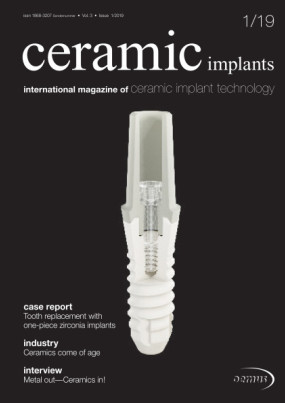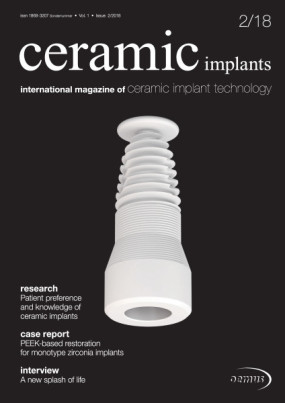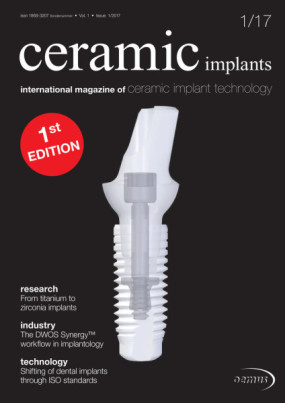Inhaltsverzeichnis
3
The past months have been game-changing for ceramic implantology. For one, manufacturers of two-piece ceramic implant systems are able to refer to new and reliable scientific long-term data. Besides the already known favourable soft-tissue reaction, the data indicates superior osseointegration compared to titanium systems. We are proud to have been able to exclusively interview Dr Roland Glauser, Switzerland, during the 2021 International Dental Show. Dr Glauser elaborates on the study design and the most important findings of the longitudinal study he conducted together with Dr Peter Schüpbach, Switzerland. On top of that, he provides insightful photo material (pages 42 and 43)....
6
This article summarises a recent peer-reviewed study that is a follow-up to a pilot study conducted in 2019 that focused on titanium-made implants and scientifically validated the implant quality assessment process utilised by the non-profit organisation CleanImplant Foundation...
8
Measuring bone density by intra-oral ultrasound for secure implant insertion
Dr Johann Lechner, Germany
In the medical field, ultrasonography is widely used to image various types of soft tissue. In principle, images of structures in the body are generated by analysing the reflection of ultrasonic waves. To derive useful information concerning the status of jawbone, different ultrasonic techniques must be employed, as the ultrasonic waves are almost completely reflected at the bone–soft-tissue interface. The in vivo measurement of ultrasonic veloc- ity in human cortical bone was introduced as a rapid, reliable and non-invasive method which could be used to analyse the mechanical properties of bone.1 Is a newly available ultrasonic device for the radiation-free measurement of bone density (CaviTAU®; Digital Dental & Healthcare Technology) suitable for visualising the con- dition of jawbone density?...
12
Dental implantation has become a mainstream treatment option, and most clinicians use titanium and titanium alloy implants in their practice. There is a growing patient demand for reliable, metal-free and naturally looking dental implants. Although niche, such demand is particularly pronounced in patients with a heightened allergic status who desire a highly aesthetic outcome...
16
Floating implants with ceramic implants and the BISS
Prof. Shahram Ghanaati, Dr Karl Ulrich Volz, Dr Rebekka Hueber & Caroline Vollmann, Germany & Switzerland
Bone atrophy is still seen as a challenge or even an obstacle to successful implant placement in both the upper and lower jaw, since osseointegration of the im plant depends largely on rigid and motionless anchorage in the bone. Often, however, the bone is too soft or too severely reduced to allow stable placement of an implant. The latter problem is especially common in the sinus region...
22
Placement of one- and two-piece ceramic implants
Prof. Belir Atalay, Dr Alper Çıldır, Dr Burcu Balkan & Dr Alanur Büyükvardar, Turkey
In recent years, there has been a tendency to avoid the use of metals in dentistry. On the one hand, patients demand aesthetic solutions, and from this point of view, metallic materials are of course inferior to ceramics. On the other hand, there is also a steadily growing number of patients who, for biological reasons, do not want any metallic materials in the oral cavity...
28
Zirconia implants have established a strong presence in implant dentistry. Patient demand for metal-free solutions is increasing, and the development of new biomaterials, micro-rough surface techniques and improved treatment protocols has enabled practices to use zirconia dental implants as a reliable treatment alternative to titanium dental implants...
32
Dr Nashat Gara, Israel Case presentation A 54-year-old male patient consulted our dental practice at the beginning of 2020 expressing the wish for the full res- toration of his teeth on the basis of implants. He appeared to be in good general health without any major background conditions. Panoramic photographs and CBCT scans were captured in the practice (Figs. 1a–2). The patient had ad- vanced aggressive periodontitis. A blood test indicated that the patient had mild hyperglycaemia and increased cholesterol levels...
34
A 65-year-old female patient presented herself with insufficient fillings, crowns and bridges in the mandible (Fig. 1). The first molar on the left side showed advanced mo- bility (Grade III). The bridgework in the anterior region was to be replaced by single-tooth crowns on the remaining natural teeth and a bridge supported by two implants in regions #32 and 42 was planned. By using the bone-splitting technique, the local bone in this area was to be enhanced (Figs. 2–5)...
36
A 35-year-old male patient presented to the clinic of the author in 2017, suffering from constant discomfort in the highly aesthetic zone between teeth #11 and 21. He revealed that he had had an accident at the age of 23 and, as a result, had undergone root canal therapy in 2004. Additionally, he had had two root tip resections in teeth #11 and 21 at another practice, in 2012 and 2014, respectively. He came to the consultation because he was unsatisfied with the prosthetic outcome of wearing fully veneered metal crowns. Unwilling to damage his remaining healthy teeth by having a bridge placed, for instance, he was looking for a metal-free implant solution...
42
Safe and fast osseointegration with two-piece zirconia implants
An interview with Dr Roland Glauser, Switzerland
Predictable osseointegration of dental implants with a strong soft-tissue seal arguably leads to healthy hard and soft tissue that are maintained in the long term. To scientifically substantiate this view, Swiss-based implantologists and researchers Dr Roland Glauser and Dr Peter Schüpbach recently conducted a study on mini-pigs to evaluate the healing around freshly inserted Patent™ zirconia implants. ceramic implants had the opportunity to speak with Dr Glauser at the 2021 International Dental Show about the study design and the implications of his findings regarding clinical application...
44
For the second year running, the International Academy of Ceramic Implantology (IAOCI) hosted its annual Congress under extremely challenging and difficult circumstances. Held from 19 to 21 August 2021, the event was also a milestone as the academy celebrated its 10th Anniversary. This year the theme was “Ceramic Implantology: Past, Present and Future”...
46
First Joint Congress for Ceramic Implantology held with great success
Caroline Vollmann, Switzerland
Renowned scientists and dental professionals from around the world with expertise on all relevant topics related to ceramic implantology gathered at the SWISS BIOHEALTH EDUCATION CENTER in the city of Kreuzlingen in Switzerland on 15 and 16 October 2021 to launch the first Joint Congress for Ceramic Implantology. From the more than 300 participants from 16 countries, 130 guests attended the event in person, making it the largest congress of its kind to date...
48
54
The development of high-performance ceramics—such as zirconium dioxide (zirconia, ZrO2)—has created new, metal-free treatment options for both patients and practitioners in various fields, including dental implantology. Owing to its superior biomechanical and biocompatible properties, zirconia has prevailed over other oxide ceramics and has been used in dentistry for about 25 years...







